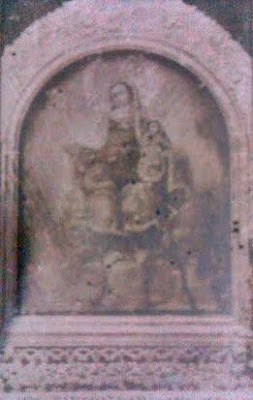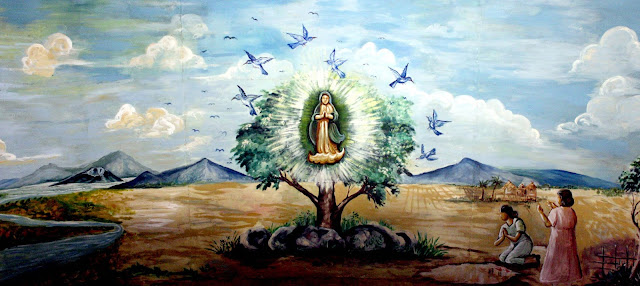Nuestra Señora del Santisimo Rosario, Reina de Caracol - Rosario, Cavite's Cause of their Joy
 |
| Nuestra Señora del Santisimo Rosario, Reina de Caracol |
The Virgin of the Rosary in Rosario, Cavite is noted for its colorful tradition of Caracol that draws thousands to millions of devotees from the surrounding towns of Cavite up to Metro Manila and other areas around the country.
The image
The icon of the Lady of the Most Holy Rosary dons the typical colors of blue and red, sitting on the clouds and holding in her left arm, she carries the Infant Jesus and in her right hand, the cross of a 15 decade Rosary. The Infant Jesus is garbed in a light blue attire. In his right hand he holds a globe with a cross on top symbolizing his role as protector of the earth. In his right left hand he holds one end of the Rosary. The scene of the icon has is unusual for instead of being seated in a throne, she is seated on a cloud visiting Purgatory, bringing relief to the suffering souls who are longing to enter heaven and join Our Lord and Our Lady in full glory.
 |
| Details of the image |
On April 21, 1984, Tony Nazareno, the president of the Antique Dealers Association of the Philippines came to examine the painting of the Virgin Mary. According to him, the image is a product of a Filipino brush. The face of Our Lady of the Most Holy Rosary is very Filipina, a rare piece in the Philippine iconography. He believed that the style of the painting belonged to a well-known painter, Faustino Quiotang, and suggested that the icon was painted sometime between 1810 and 1820.
History
 |
Rosario is a coastal town in the province of Cavite along the shores of Manila Bay. It was formerly a barrio or (barangay) of the town of San Francisco de Malabon (now General Trias). It was then called Salinas-Marsella for its salt evaporation industry. Marsella, on the other hand, comes from the Spanish word ‘’mar’’ (sea). It was named so because of its proximity to the sea.However, before the twilight of the Spanish era its name was changed to Rosario in honor of the "Virgen del Rosario de Caracol" which was the patroness of the place. How this image of the Virgin came to the town is unknown and shrouded with mystery.
However, Don Catalino Abueg and Dona Rosa Ner, Rosario's most respected couple of Rosario relates the origin of the Virgin's arrival to town.
 During the Spanish colonial period, one of the best means of transportation was by boat. Cargoes from the south were brought to Manila by big boats, and there were many batel (fishing boats) in Manila bay. One day, a strong typhoon visited Manila and the area that caused great destruction of life and properties . Countless fishermen as well as merchants were caught by the turbulent wind in the midst of the sea. One of these boats coming from Mindoro was loaded with merchandise. As the strong typhoon hits the sea, the crewmen of the boat, filled with terror as death approaches, tied themselves to the boat so they would not be thrown overboard. The head of the crew went inside the cabin to check whatever goods he could save. As he moved around, he noticed the framed image of the Lady of the Most Holy Rosary hanging on a post. A strong wind rocked the boat that made the frame swing to the point of almost being dropped in the water. The sight of the image gave him a little light of hope for safety. He beg the virgin to spare his life and that of his companions with the promise that they would build a chapel in her honor as soon as they landed on the shore. The Virgin must have heard his prayers for they were all saved.
During the Spanish colonial period, one of the best means of transportation was by boat. Cargoes from the south were brought to Manila by big boats, and there were many batel (fishing boats) in Manila bay. One day, a strong typhoon visited Manila and the area that caused great destruction of life and properties . Countless fishermen as well as merchants were caught by the turbulent wind in the midst of the sea. One of these boats coming from Mindoro was loaded with merchandise. As the strong typhoon hits the sea, the crewmen of the boat, filled with terror as death approaches, tied themselves to the boat so they would not be thrown overboard. The head of the crew went inside the cabin to check whatever goods he could save. As he moved around, he noticed the framed image of the Lady of the Most Holy Rosary hanging on a post. A strong wind rocked the boat that made the frame swing to the point of almost being dropped in the water. The sight of the image gave him a little light of hope for safety. He beg the virgin to spare his life and that of his companions with the promise that they would build a chapel in her honor as soon as they landed on the shore. The Virgin must have heard his prayers for they were all saved. |
| Our Lady of the Most Holy Rosary Parish, Rosario, Cavite |
 Devotion
DevotionThe town fiesta of Rosario or the feast of Our Lady of the Most Holy Rosary is celebrated twice a year, the first is in the month of May held during the second Sunday of the month. In some instances, it is moved to the third Sunday when it is close in proximity to the fiesta of Saint Isidore the Laborer. The second is on October 7 to celebrate the feast of Our Lady of the Most Holy Rosary.
 The festivities include the ritual dance-procession called "Caracol" (also spelled "karakol", meaning "prayer through dancing"). During the eve of the fiesta, the Virgin is placed on an andas during the dance-procession, which is then carried on the shoulders by her devotees . The andas of the Virgin is heavily decorated with curtains and flowers. From the church, majority of those who participate in the Caracol procession also dances to the lively tune of "Pandanggo" or any Philippine folk music provided by the town's brass marching bands, hired to provide musical accompaniment to the procession. The float of the Virgin Mary is also swayed to the music while it is being paraded around town. Together with the dancing, the procession is a slow snail-like pace (the origin of the word "caracol", the Spanish word for snail or possibly from the word |"Caracoa", a sea vessel commonly used at that time). The image of the Virgin Mary is brought towards the shore of Manila Bay for a fluvial procession.
The festivities include the ritual dance-procession called "Caracol" (also spelled "karakol", meaning "prayer through dancing"). During the eve of the fiesta, the Virgin is placed on an andas during the dance-procession, which is then carried on the shoulders by her devotees . The andas of the Virgin is heavily decorated with curtains and flowers. From the church, majority of those who participate in the Caracol procession also dances to the lively tune of "Pandanggo" or any Philippine folk music provided by the town's brass marching bands, hired to provide musical accompaniment to the procession. The float of the Virgin Mary is also swayed to the music while it is being paraded around town. Together with the dancing, the procession is a slow snail-like pace (the origin of the word "caracol", the Spanish word for snail or possibly from the word |"Caracoa", a sea vessel commonly used at that time). The image of the Virgin Mary is brought towards the shore of Manila Bay for a fluvial procession. Once the dance-procession reaches the seashore, the image of the Virgin is then boarded on a big fishing boat. While at the sea, hundreds of smaller fishing boats go around the Marian boat as veneration to the Virgin. Music is provided by the brass band also loaded on their boats. Adding color to the fluvial parade, participating boats displays different colorful banners during the fluvial parade. From Barangay Wawa, The image is brought to Barangay Muzon where it lands. From Muzon, the Virgin is once again brought back to the church with the "Karakol sa lupa" or "Caracol de la Tierra".
Once the dance-procession reaches the seashore, the image of the Virgin is then boarded on a big fishing boat. While at the sea, hundreds of smaller fishing boats go around the Marian boat as veneration to the Virgin. Music is provided by the brass band also loaded on their boats. Adding color to the fluvial parade, participating boats displays different colorful banners during the fluvial parade. From Barangay Wawa, The image is brought to Barangay Muzon where it lands. From Muzon, the Virgin is once again brought back to the church with the "Karakol sa lupa" or "Caracol de la Tierra". |
| The Caracol during the Intramuros Grand Marian Procession |
The devotion to the Santo Rosario, Reina de Caracol continues to thrive even in our modern times. People continue to flock the Parish and yearly, millions continue to join the Caracol Festivities and marvelous miracles were also reported and this once again proves that it is Our Lord and His loving Mother is our source of Joy and celebration - something that material wealth cannot be matched.





Why is the Patrona or Reina (Popular calling to her) always lands in Barangay Muzon?
ReplyDeleteAccording to my Interview to the locals of Salinas, the Place of Muzon is very Special, because according to them this is where the Virgin Arrives with the locals of Mindoro, (Just like what you said), so to commemorate the event of the Miracle, the Caracol del Mar always ends in Muzon where the route of the Caracol will passed through in a "Galilea" type of Arch or "Arko" where according to tradition where the first chapel was built.
I was very fortunate to visit this image and the Church where it resides during a Visita Iglesia of Cavite. It's a very lovely image, worthy of Our Lady.
ReplyDelete